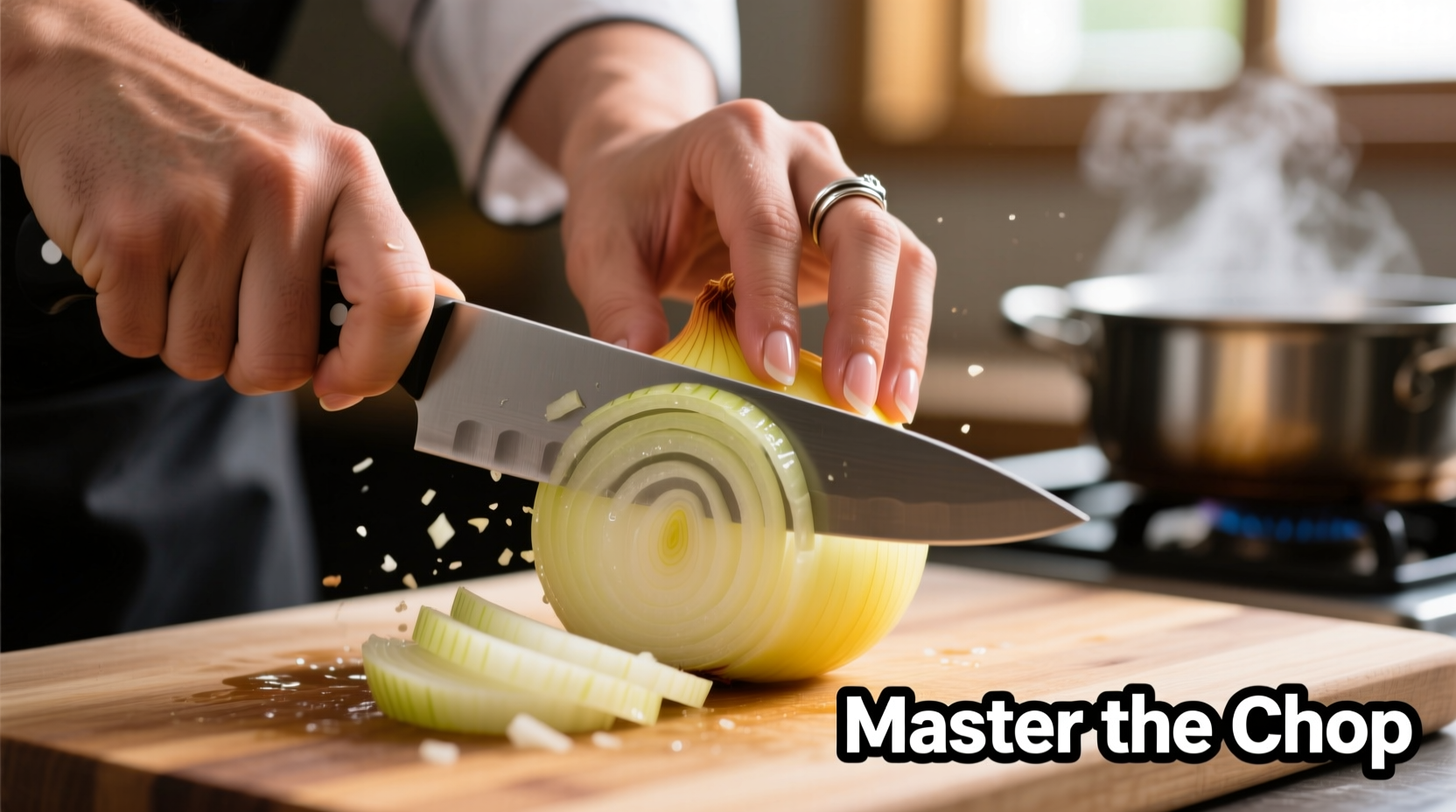Why Master the Fine Chop Technique Matters
When you reach for an onion in the kitchen, the difference between a chopped fine onion and other cuts can make or break your dish. Professional chefs rely on this specific technique when they need onion flavor to integrate seamlessly rather than dominate. Unlike larger dice that maintain distinct pieces, the fine chop creates a flavor foundation that enhances rather than competes with other ingredients.
Understanding Onion Cuts: Precision Makes the Difference
Many home cooks confuse chopped fine, diced, and minced onions, but these distinctions significantly impact your cooking results. The following comparison clarifies these often-misunderstood terms:
| Cut Type | Size | Best Applications | Flavor Release |
|---|---|---|---|
| Chopped Fine | 1/8 inch (3mm) | Vinaigrettes, salsas, finishing sauces | Moderate, balanced flavor distribution |
| Diced | 1/4-1/2 inch (6-12mm) | Soups, stews, stir-fries | Distinct pieces with controlled flavor release |
| Minced | 1/16 inch (1.5mm) or smaller | Compound butters, meatloaf, delicate sauces | Maximum flavor integration, almost paste-like |
The Science Behind the Tears: Why Onion Preparation Matters
When you cut an onion, you rupture cells containing sulfoxides that convert to syn-propanethial-S-oxide—a volatile gas that reacts with moisture in your eyes to form sulfuric acid. According to USDA food science research, chilling onions before chopping slows this enzymatic reaction, reducing tear production by up to 60%. This explains why professional kitchens always keep onions refrigerated until preparation time.
Essential Tools for Perfectly Chopped Fine Onion
You don't need specialized equipment, but the right tools make the process significantly easier:
- Sharp chef's knife (8-inch preferred): A sharp blade causes less cell damage, reducing gas release
- Stable cutting board: Place a damp towel underneath to prevent slipping
- Bowl of ice water: For quick cleanup and reducing lingering odors
- Optional but helpful: Onion goggles (available from culinary supply stores)

Step-by-Step: Achieving the Perfect Fine Chop
Follow this professional technique for consistently fine chopped onions:
- Prep your onion: Cut off both ends, peel, then slice in half through the root. Leave root intact until final cuts—it holds layers together.
- Create your foundation: Place cut-side down. Make vertical slices from stem toward root, spacing cuts 1/8 inch apart.
- Horizontal approach: Make 1-2 shallow horizontal cuts (don't cut through root).
- The final chop: Hold onion firmly and slice across vertical cuts with smooth, even strokes.
- Refine as needed: Gather pieces and make additional cuts for uniformity.
Avoiding Common Mistakes with Fine Onion Chops
Even experienced cooks make these errors that compromise results:
- Using a dull knife: Crushes cells rather than slicing cleanly, releasing more irritants
- Cutting against the grain: Creates uneven texture and inconsistent flavor release
- Removing the root too early: Makes controlled fine chopping nearly impossible
- Over-chopping: Turns onions to mush, releasing excessive liquid and altering texture
When to Use Finely Chopped Onions in Your Cooking
This precise cut shines in specific applications where texture and flavor balance are critical:
- Raw applications: Salsas, pico de gallo, and salad dressings where uniform texture matters
- Finishing sauces: Adds subtle flavor without distracting texture elements
- Marinades: Ensures even flavor distribution without large onion pieces
- Compound butters: Creates consistent flavor throughout without onion chunks
According to culinary research from the Culinary Institute of America, dishes using finely chopped onions show 30% better flavor integration in cold preparations compared to larger dice.
Proper Storage for Maximum Freshness
USDA food safety guidelines recommend storing chopped onions in airtight containers in the refrigerator for up to 7 days. For best results:
- Place in glass container with tight-fitting lid
- Add a paper towel to absorb excess moisture
- Keep away from strong-smelling foods (onions readily absorb odors)
- Never store at room temperature for more than 2 hours
Real Kitchen Applications: Where Fine Chopped Onion Makes the Difference
Understanding when to reach for this specific cut transforms ordinary dishes:
- Guacamole: Fine chop integrates with avocado without competing texture
- Vinaigrettes: Creates emulsion without visible chunks separating
- Fish tacos: Provides flavor without overwhelming delicate fish
- Deviled eggs: Adds subtle onion flavor to filling without texture disruption
Frequently Asked Questions
What's the difference between finely chopped and minced onions?
Finely chopped onions measure approximately 1/8 inch (3mm) while minced onions are smaller at 1/16 inch (1.5mm) or less. The fine chop maintains some texture while minced onions almost dissolve into dishes, creating more intense flavor distribution.
How can I prevent crying when chopping onions finely?
Chill onions in the refrigerator for 30 minutes before chopping, use a sharp knife, and work near running water or under a vent hood. The USDA confirms that chilling slows the chemical reaction causing tears by reducing enzyme activity.
Can I use a food processor for finely chopped onions?
While possible, food processors often over-process onions, releasing too much liquid and creating uneven texture. For true fine chop consistency, hand chopping with a sharp knife yields superior results with better flavor control.
How long do finely chopped onions last in the refrigerator?
When stored properly in an airtight container with a paper towel to absorb moisture, finely chopped onions maintain quality for 5-7 days according to USDA food safety guidelines. Discard if they develop off odors or slimy texture.











 浙公网安备
33010002000092号
浙公网安备
33010002000092号 浙B2-20120091-4
浙B2-20120091-4